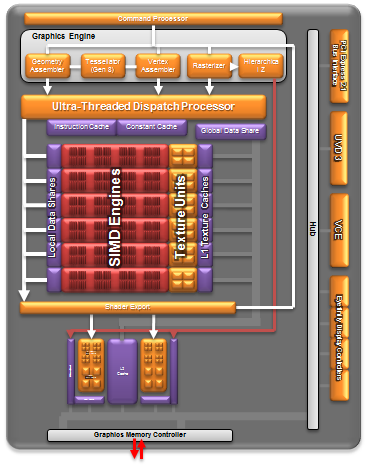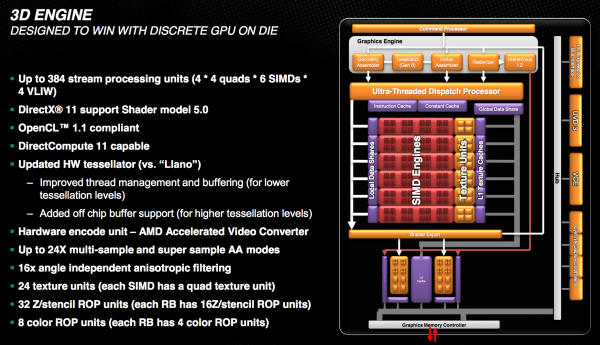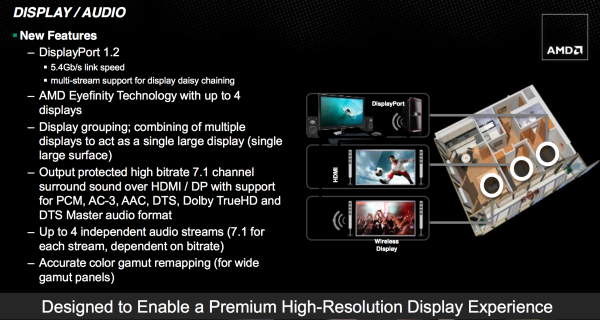The AMD Trinity Review (A10-4600M): A New Hope
by Jarred Walton on May 15, 2012 12:00 AM ESTImproved Turbo
Trinity features a much improved version of AMD's Turbo Core technology compared to Llano. First and foremost, both CPU and GPU turbo are now supported. In Llano only the CPU cores could turbo up if there was additional TDP headroom available, while the GPU cores ran no higher than their max specified frequency. In Trinity, if the CPU cores aren't using all of their allocated TDP but the GPU is under heavy load, it can exceed its typical max frequency to capitalize on the available TDP. The same obviously works in reverse.
Under the hood, the microcontroller that monitors all power consumption within the APU is much more capable. In Llano, the Turbo Core microcontroller looked at activity on the CPU/GPU and performed a static allocation of power based on this data. In Trinity, AMD implemented a physics based thermal calculation model using fast transforms. The model takes power and translates it into a dynamic temperature calculation. Power is still estimated based on workload, which AMD claims has less than a 1% error rate, but the new model gets accurate temperatures from those estimations. The thermal model delivers accuracy at or below 2C, in real time. Having more accurate thermal data allows the turbo microcontroller to respond quicker, which should allow for frequencies to scale up and down more effectively.
At the end of the day this should improve performance, although it's difficult to compare directly to Llano since so much has changed between the two APUs. Just as with Llano, AMD specifies nominal and max turbo frequencies for the Trinity CPU/GPU.
A Beefy Set of Interconnects
The holy grail for AMD (and Intel for that matter) is a single piece of silicon with CPU and GPU style cores that coexist harmoniously, each doing what they do best. We're not quite there yet, but in pursuit of that goal it's important to have tons of bandwidth available on chip.
Trinity still features two 64-bit DDR3 memory controllers with support for up to DDR3-1866 speeds. The controllers add support for 1.25V memory. Notebook bound Trinities (Socket FS1r2 and Socket FP2) support up to 32GB of memory, while the desktop variants (Socket FM2) can handle up to 64GB.
Hyper Transport is gone as an external interconnect, leaving only PCIe for off-chip IO. The Fusion Control Link is a 128-bit (each direction) interface giving off-chip IO devices access to system memory. Trinity also features a 256-bit (in each direction, per memory channel) Radeon Memory Bus (RMB) direct access to the DRAM controllers. The excessive width of this bus likely implies that it's also used for CPU/GPU communication as well.
IOMMU v2 is also supported by Trinity, giving supported discrete GPUs (e.g. Tahiti) access to the CPU's virtual memory. In Llano, you used to take data from disk, copy it to memory, then copy it from the CPU's address space to pinned memory that's accessible by the GPU, then the GPU gets it and brings it into its frame buffer. By having access to the CPU's virtual address space now the data goes from disk, to memory, then directly to the GPU's memory—you skip that intermediate mem to mem copy. Eventually we'll get to the point where there's truly one unified address space, but steps like these are what will get us there.
The Trinity GPU
Trinity's GPU is probably the most well understood part of the chip, seeing as how its basically a cut down Cayman from AMD's Northern Islands family. The VLIW4 design features 6 SIMD engines, each with 16 VLIW4 arrays, for a total of up to 384 cores. The A10 SKUs get 384 cores while the lower end A8 and A6 parts get 256 and 192, respectively. FP64 is supported but at 1/16 the FP32 rate.

As AMD never released any low-end Northern Islands VLIW4 parts, Trinity's GPU is a bit unique. It technically has fewer cores than Llano's GPU, but as we saw with AMD's transition from VLIW5 to VLIW4, the loss didn't really impact performance but rather drove up efficiency. Remember that most of the time that 5th unit in AMD's VLIW5 architectures went unused.
The design features 24 texture units and 8 ROPs, in line with what you'd expect from what's effectively 1/4 of a Cayman/Radeon HD 6970. Clock speeds are obviously lower than a full blown Cayman, but not by a ton. Trinity's GPU runs at a normal maximum of 497MHz and can turbo up as high as 686MHz.
Trinity includes AMD's HD Media Accelerator, which includes accelerated video decode (UVD3) and encode components (VCE). Trinity borrows Graphics Core Next's Video Codec Engine (VCE) and is actually functional in the hardware/software we have here today. Don't get too excited though; the VCE enabled software we have today won't take advantage of the identical hardware in discrete GCN GPUs. AMD tells us this is purely a matter of having the resources to prioritize Trinity first, and that discrete GPU VCE support is coming.















271 Comments
View All Comments
Spunjji - Wednesday, May 16, 2012 - link
Go away, please.silverblue - Thursday, May 17, 2012 - link
Can you and sans2212 go into a room and fight it out, please? One of you hates AMD, the other wants its babies, and I've a sneaky suspicion that, like matter and antimatter, you might actually cancel each other out.(they also both cease to exist, but I thought that'd be a bit cruel)
e36Jeff - Tuesday, May 15, 2012 - link
oh well, thanks for checking, and thanks for the reply. I guess I'll just have to wait for you guys to get your hands on an actual LV/ULV trinity chip.plonk420 - Tuesday, May 15, 2012 - link
is the Dell V131 tested 2, 4, or 6gb? (i.e. single or dual channel) and how about the other laptops?JarredWalton - Tuesday, May 15, 2012 - link
I actually stuck in 2x4GB DDR3-1600 from the IVY system to make things "equal". Sorry for not noting that. I did the same for Llano, Trinity, and QC SNB. Same SSD, same RAM -- though Llano and SNB ran the RAM at DDR3-1333.Iketh - Tuesday, May 15, 2012 - link
Awesome article Jarred!I caught only one mistake...
"Power consumption is also improved over Llano, making Trinity is a win across the board for AMD compared to its predecessor."
SuperVeloce - Tuesday, May 15, 2012 - link
"Llano was already faster in general use than Core 2 Duo and Athlon X2 class hardware."This is so wrong, it's beggar belief. Just for comparison, my old C2D T8300 (2,4ghz, 3mb L2) is actually faster than A4-3300 overclocked to 2,8ghz in every task and benchmark i throw at them. Even at 2,6ghz it's only on par with T7500 (2,2ghz, 4mb L2, year 2006 my friends).
Well yes, I guess A4 (not overclocked) is less power-hungry and can do quite a bit of undervolting but you see my point... liano is slower than equivalent mobile c2d, if Open-CL from gpu is not in use.
JarredWalton - Tuesday, May 15, 2012 - link
Care to provide some specific benchmarks that prove this out? Because by my numbers, it doesn't look that way:http://www.anandtech.com/show/2585/6
I didn't post Cinebench 10 in the article, but Trinity scores 2834 single-threaded and 8222 multi-threaded. That makes the single-threaded score basically tied with the Core 2 Duo X7900 (2.8GHz) and the multi-threaded score is 50% faster. Llano on the other hand scores 2037 and 6824 in the same tests -- slightly slower than P8400 on single threads but faster on multi-threaded.
PCMark 05 I can provide results for as well, though the SSD certainly skews things on Trinity. Trinity = 10824, Llano (HDD) = 6236, P8400 = 6561 (close enough to Llano), and X7900 = 7544. But I'm not talking specific tasks; I simply said "faster in general use" -- depending on which version of Llano you're talking about. The fastest Core 2 vs. the slowest A8 would probably be a tossup on the CPU side.
eanazag - Tuesday, May 15, 2012 - link
I am disappointed that the desktop versions are not available till Q3. I was thinking this would replace my Core i3 540 at home soon.PolarisOrbit - Tuesday, May 15, 2012 - link
I am wondering if there is a better way to communicate value other than pricing because throughout the article the reviewer estimates Trinity at $600, while in the comments to readers the same reviewer's estimates vary from $700-$800.What is to be made of this discrepency? I am wondering if it wouldn't be better to just avoid price predictions altogether. Surely there is some other way of describing relative value. Maybe estimates of what other setups would have similar performance is enough by itself.